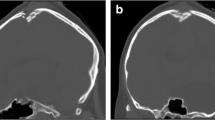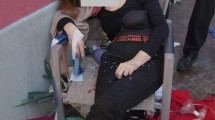Abstract
Gyroplanes are mainly used for sports aviation. Experience is required when flying these special aircraft because in 40% of gyroplane crashes, the passengers do not survive. Herein, a fatal gyroplane crash of a tandem-seat gyroplane with two occupants is reported. The occupants, both 49-year-old males, fell from a height of approximately 20 m to 30 m. In both cases, the cause of death was polytrauma with typical findings of deceleration trauma. The pilot, who probably lost his helmet in the crash, had a ring fracture at the base of his skull. As there is not much literature on autopsy findings in the case of light aircraft crashes, these autopsy findings are presented and discussed.







Similar content being viewed by others
References
de Voogt AJ, van Doorn RR. Sports aviation accidents: fatality and aircraft specificity. Aviat Space Environ Med. 2010;81:1033–6.
Pagán BJ, de Voogt A. Gyroplane accidents 1985-2005: epidemiological analysis and pilot factors in 223 events. Aviat Space Environ Med. 2008;79:983–5.
Hasselquist A, Baker SP. Homebuilt aircraft crashes. Aviat Space Environ Med. 1999;70:543–7.
Ast FW, Kernbach-Wighton G, Kampmann H, Koops E, Püschel K, Tröger HD, et al. Fatal aviation accidents in Lower Saxony from 1979 to 1996. Forensic Sci Int. 2001;119:68–71.
Shkrum MJ, Hurlbut DJ, Young JG. Fatal light aircraft accidents in Ontario: a five year study. J Forensic Sci. 1996;41:252–63.
Hellerich U, Pollak S. Airplane crash. Traumatologic findings in cases of extreme body disintegration. Am J Forensic Med Pathol. 1995;16:320–4.
Madea B, Schmidt P, Doberentz E. Helicopter induced propeller injuries. Forensic Sci Med Pathol. 2015;11:622–5.
Atanasijevic TC, Savic SN, Nikolic SD, Djokic VM. Frequency and severity of injuries in correlation with the height of fall. J Forensic Sci. 2005;50:608–12.
Türk EE, Tsokos M. Pathologic features of fatal falls from height. Am J Forensic Med Pathol. 2004;25:194–9.
Rowbotham SK, Blau S, Hislop-Jambrich J, Francis V. An assessment of the skeletal fracture patterns resulting from fatal high (˃3 m) free falls. J Forensic Sci. 2019;64:58–68.
Jang JH, Kim JS. Pontomedullary laceration, a fatal consequence of skull base ring fracture. J Korean Neurosurg Soc. 2014;56:534–6.
Konrad CJ, Fieber TS, Schuepfer GK, Gerber HR. Are fractures of the base of the skull influenced by the mass of the protective helmet? A retrospective study in fatally injured motorcyclists. J Trauma. 1996;41:854–8.
Reals WJ, Davidson WH, Karnitschnig HH. Pathology of light-aircraft accidents. Aerosp Med. 1964;35:133–5.
Stevens PJ. Aviation accident pathology. The search for the cause of an accident. Proc R Soc Med. 1968;61(11 Part 1):1076–9.
Harper CR, Albers WR. Alcohol and general aviation accidents. Aerosp Med. 1964;35:462–4.
Günther D, Ast FW, Tröger HD, Kleemann WJ. Unexpected findings in the investigation of an airplane crash. Forensic Sci Int. 1999;104:189–94.
Kleiber M. A suicide decision as a motive for murder--an airplane as the murder weapon. Arch Kriminol. 1987;179:154–60.
Pagán BJ, De Voogt AJ, Van Doorn RR. Ultralight aviation accident factors and latent failures: a 66-case study. Aviat Space Environ Med. 2006;77:950–2.
Stevens PJ. Fatal accidents involving light aircraft: a review of UK experience, 1956-66. Aerosp Med. 1968;39:622–7.
Author information
Authors and Affiliations
Corresponding author
Ethics declarations
Conflict of interest
No conflicts of interest. The corresponding author declares also on behalf of her co-authors there is no conflict of interest.
Ethical approval
This article does not contain any studies with human participants or animals.
Additional information
Publisher’s note
Springer Nature remains neutral with regard to jurisdictional claims in published maps and institutional affiliations.
Rights and permissions
About this article
Cite this article
Doberentz, E., Geile, J. & Madea, B. Fatal gyroplane crash. Forensic Sci Med Pathol 16, 705–709 (2020). https://doi.org/10.1007/s12024-020-00253-0
Accepted:
Published:
Issue Date:
DOI: https://doi.org/10.1007/s12024-020-00253-0




